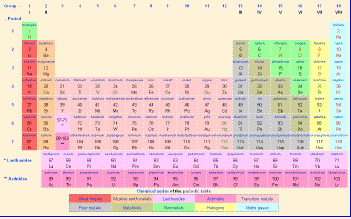Mendeleev and the Benefits of Matrix Taxonomies

Juan Dürsteler has a good article on Mendeleev’s Periodic Table of Elements in this month’s Info@vis Magazine. Dürsteler is looking at the table as an early classic example of information visualisation – in my book, I come at it more as an example of a matrix type of taxonomy. But Dürsteler’s article nicely captures some of the most important benefits of this type of taxonomy (I quote):
“Knowledge Transmission. The table is very good at communicating in a very concise yet powerful way the existing knowledge about the properties of the elements.
Pattern detection. The columns of the table correspond to groups of elements sharing the same chemical and physical properties. Today we know that all the elements in the same column have identical electronic configuration of the last layer, that is none other than the one that defines the valence and its interaction properties with other elements. Rows group elements of different properties but similar weights. Technically we would say that they have the same number of atomic orbitals. Something unknown in Mendeleev’s time.
Knowledge discovery. By leaving holes when no known element had the appropriate periodicity had the extraordinary effect of facilitating the discovery of new elements together with the prediction of its properties with great accuracy. Maybe this was one of the most outstanding features of the table in its time.”
Just to top it off nicely, Dürsteler finishes with links to other visualisations using the periodic table format, including a table of condiments that go bad... giving their periods of edibility. Periodic indeed!
Thanks to Maish for this reference.
0 Comment so far
Commenting is not available in this weblog entry.Comment Guidelines: Basic XHTML is allowed (<strong>, <em>, <a>) Line breaks and paragraphs are automatically generated. URLs are automatically converted into links.
